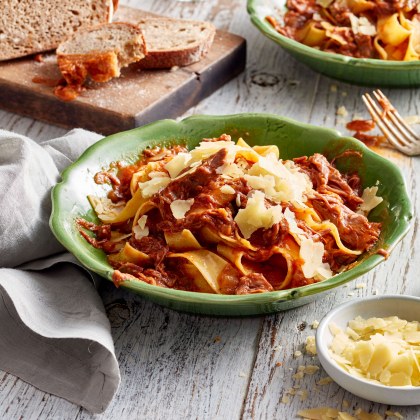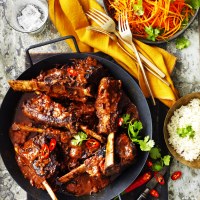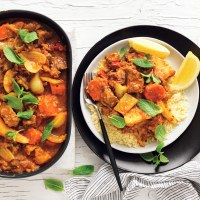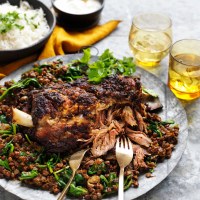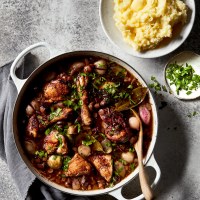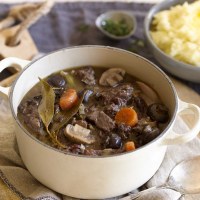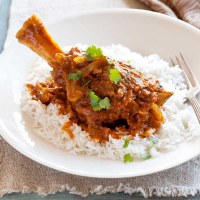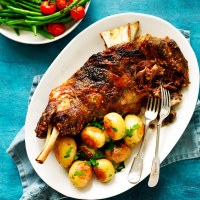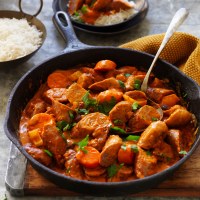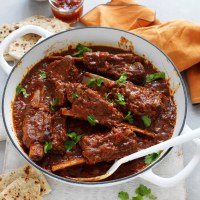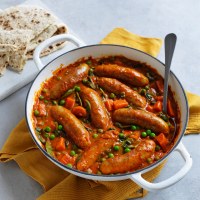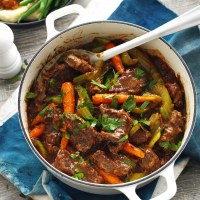What not to put in a slow cooker
Although we adore our slow cookers for everything from pot roasts to puddings, there are some ingredients that just aren’t meant to live the low and slow life. Where the slow cooker is meant to promise tender and tasty meals, these ingredients can turn out tough, mushy or plain unappetising. Find out what not to put in your slow cooker, and what to use instead.
What shouldn’t be cooked in a slow cooker?
1. Lean, tender cuts of meat
Lean, tender (and usually more expensive cuts) will actually become dry and tough if you cook them in a slow cooker! Choose cuts of meat that are considered “tough” cuts. These include shoulders, shanks, chuck and cheeks. The tough connective tissue and fat actually becomes tender and tasty when it’s slow cooked. Not only that, they’re usually much cheaper! It’s a win-win.
2. Meat with skin left on
Skin left on cuts of meat destined for a slow cooker will end up flabby and unappetising. Even if the skin is browned first, after it’s slow cooked that crispiness will become soft and mushy. Instead, take off any skin and brown the meat directly to add flavour and colour to your dish.
3. Too much liquid
Meats and vegetables release liquid as they cook in a slow cooker. Because the heat it so low, there’s very little evaporation, so this can lead to a watery, flavourless dish if you add too much liquid at the beginning. To avoid this, follow the recipe and carefully measure the water or stock. If you’re making a stew with a recipe that wasn’t written for the slow cooker, halve the amount of liquid. You can always top it up during the cooking time if it looks too dry.
4. Delicate vegetables
Just like meat, slow cooking is great for tenderising tougher veggies. Root vegetables like carrots, parsnips and turnips work well. Avoid soft and delicate vegetables like zucchini, asparagus and pumpkin, as they will turn soft and pulpy. If you do want to use these soft vegetables, cut them into large chunks or add them in the last 2 hours of cooking.
5. Fresh herbs and spices
The delicate flavour of fresh herbs such as coriander, basil and parsley will be obliterated by the slow cooker. Harder herbs such as rosemary and bay leaf are the exception. If using fresh soft herbs, add them just before serving. This adds freshness to the dish and also gives maximum flavour.
Otherwise, use dried spices. Dried herbs and spices actually benefit from the moisture and low, slow cooking. Their flavours can tend to mellow out during the extended cooking time, so if you’re converting a stove top recipe you can add more herbs to your taste.
6. Milk and cream
Creamy ingredients (whether they’re dairy or non-dairy) can split in a slow cooker. Avoid adding milk, cream, yoghurt, coconut cream or coconut milk at the beginning of cooking as it can end up curdled and grainy. For the best results, stir through at the end of the cooking time and warm through gently without boiling.
7. Alcohol
Many stews call for wine, beer or other alcohol as a flavour enhancer. However, slow cookers don’t reach the temperature needed to boil away the alcohol, so you’ll end up with an unpleasant, alcoholic taste instead of mellow flavours. Instead of adding wine or other beverages straight to the slow cooker, simmer first in a separate pan for 5-10 minutes or until quantity is reduced by half. Then pour into slow cooker and stir through.
8. Seafood
Fish and shellfish tend to be very lean and don’t fare well in the slow cooker. They turn out grainy and dry. The only exceptions are squid and octopus, which can benefit from slow cooking to tenderise them.
9. Pasta
Pasta can be difficult to cook successfully in a slow cooker. It’s easy to overcook, and the pasta will soak up a lot of liquid from your dish and can become gluggy. The easiest solution is to cook the pasta separately and then add it to the dish.
However, if you want to cook pasta directly in the slow cooker, the best tips are to add dried pasta 15-20 minutes before the end of the cook time. Check your pasta every now and then to avoid it overcooking. Make sure there is enough liquid to cook the pasta, and that the pasta is fully submerged to ensure even cooking.
10. Rice
Like pasta, rice is easy to get wrong in a slow cooker, unless you’re making congee (rice porridge). If you’re aiming for fluffy rice, follow these steps: Rinse rice thoroughly to remove excess starch. For every 1 cup of rice, add 1.5 cups of water. Cook on low for 2 hours or until tender.
11. Frozen food
Slow cookers use a very low heat to cook, and adding in frozen meat or vegetables means that it can take much longer for the cooker to get up to heat. Not only does this mean your cooking times will be much longer, you also run the risk of food poisoning since the food won't come to a safe temperature for a long time. Don't put frozen meats or vegetables into the slow cooker! Instead, defrost them in the fridge, or in the microwave if you're short on time.
Slow cooker recipes
Now you know what you shouldn't put in a slow cooker, get recipes below that you definitely should put in a slow cooker! From glorious shanks to spicy short ribs, beef casseroles and more, these recipes have been tried and tested so are sure to leave you with a tasty meal. If you want even more recipes, click for a collection of slow cooker recipes that are great for beginners, or get more easy slow cooker tips.
GET THE RECIPE: Sri Lankan Lamb Shank Curry by Passage to India
This stunning curry couldn't be simpler, pop the ingredients in to cook and get ready for a Sri Lankan-spiced feast.
Lamb shoulder is a fantastic cut for slow cooking. The meat is extra flavourful because it's near the bone, and with slow cooking it becomes fall-off-the-bone tender.
GET THE RECIPE: Slow Cooked Butter Chicken Sausages by Passage to India
Grab a pack of your favourite sausages along with family favourite Butter Chicken Sauce and cook up a sausage curry like no other!


